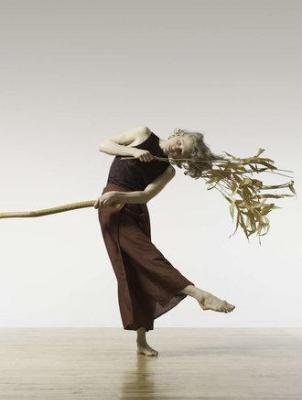By Merilyn Jackson, for The Inquirer
Have you ever found yourself suddenly surrounded by dance, and in the least expected place? Maybe you couldn’t quite grasp what was going on at first, but then you noticed people standing around or sitting on the grass, watching. If you’ve lived in Philadelphia for awhile and walked in Bartram Gardens, Fairmount Park, or Old City, or visited Swarthmore College’s campus, or toured Eastern State Penitentiary, chances are you’ve been surprised at least once by dance.
No, you didn’t just cross over into the Twilight Zone. But if your encounter was Leah Stein and her dancers performing what’s now called “site specific” work, you were indeed “moving into a land of shadow and substance, of things and ideas” – and, I would add, the mystery of human bodies moving in the midst of nature and architecture.
An early and expert practitioner of the genre, Stein has been creating site-specific and stage dance since coming to Philadelphia straight out of Wesleyan University in 1987. Ten years ago, she formed her own company here. Philadelphia Dance Projects celebrates its 10th anniversary by presenting a retrospective of Stein’s work Thursday through Sunday at the Performance Garage.
Terry Fox, director of Philadelphia Dance Projects, said, “We’re presenting her as part of our seasonal series because she’s an important figure in our dance community. Leah created and worked for a long time as an independent artist [before creating her company], and I wanted to celebrate that milestone.”
Fox, after placing her own significant footprint on the local dance scene, was twice director of the Painted Bride Art Center’s “Dance With the Bride” series, with a stint at New York’s St. Mark’s Church series in between.
“We commissioned a work at the Bride from Leah in 1993 called Bees of the Invisible,” she said. “I had seen her perform in Fairmount Park and in Susan Hess Studio and asked if she’d like to create work for an interior space.”
Stein had studied French and dance at the Université de Toulouse de Mirail in France, and in Philadelphia she continued her modern technique studies at Temple University with Helmut Gottschild and Eva Gohlson.
“But I got my first paying dance job with Ellen Forman and her South Street Dance Company,” Stein said, and after Forman’s death in 1990, she continued to teach in the Young Audience Program Forman had founded.
She now teaches contact-improvisation dance repertory at Swarthmore and is making a dance on the students there this spring, “a site-specific work on campus – a totally different piece also based on A Lily Lilies that you’ll see this weekend.”
She also teaches improvisation at Bryn Mawr College and talked about the difference between contact improv and improvisation. “Contact improv, as it’s called, is a dance practice developed in late ’60s in the U.S. with a focus on sharing weight and experiencing gravity, momentum, and suspension – the physics of the moving human body,” she said. “It’s very democratic, but not part of dance unless you want it to be. Improvisation doesn’t exclude contact, and since I’m comfortable with weight sharing, I use it.”
At 47, Stein is now happily partnered in life with a painter and dancing as lithely as ever. A January performance showed her with a greater sureness of step, her sometimes blushing self-consciousness at bay as she engaged more openly with the audience. There was still a girlish quality, sensual but innocent of eroticism.
Dance scholar Brenda Dixon Gottschild once compared Stein to the groundbreaking choreographer Trisha Brown. And dance and art critic Miriam Seidel, who was swept up in Stein’s work in the early stages of her performances here, said, “There’s something so spontaneous about her dances.”
In her program essay for this weekend’s performances, Seidel remembers 1993’s Departure, in the tall grass of a Fairmount Park meadow in the late-afternoon summer sun, “as if it were happening now. Her outdoor work has this gently transgressive and powerful effect.”
Stein said the weekend program “is a collection of pieces, and a short improvisation with [tap dancer] Germaine Ingram at the end of the show.” It includes two current works in progress. One is the aforementioned A Lily Lilies, celebrating ideas about landscape and language shared between Stein and poet Josey Foo, with whom Stein also collaborated on a book of the same name that was published last fall.
“I asked Josey for poems called Imprint in 2002 and always wanted to revisit it. We had a similar collection through landscape [and] she wanted me to be part of the process – the stage to the page and to the stage again.”
Jungwoong Kim will join Stein for the duet Kite, and her longtime collaborator, acclaimed sound artist Toshi Makihara, will perform live with her.
The company, which also includes Ellen Gerdes, David Konyk, Shavon Norris, Jumatatu Poe, and Michelle Tantoco, will present excerpts of the in-progress interdisciplinary work Hull, a reflection on what it means to be lost at sea, as well as Battle Hymns, Stein’s collaboration with Pulitzer Prize-winning composer David Lang. Inspired by letters and songs of the Civil War, it premiered during 2009’s Hidden City Festival.
There is so much immediacy in Stein’s work that, as Alan Harler, director of the Mendelssohn Club of Philadelphia, the other major collaborator in Battle Hymns, noted with awe at the time, “She brought in a live horse and rider to our performance at the last minute.” Who knows what serendipitous element she’ll incorporate at the Performance Garage?
Dance/Leah Stein Dance Company
7:30 p.m. Thursday, Friday, and Saturday, and 2 p.m. Sunday at the Performance Garage, 1515 Brandywine St.
Tickets: $20-$25. www.leahsteindance.org or www.danceboxoffice.com

